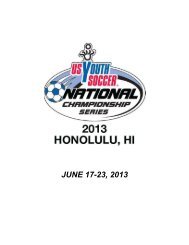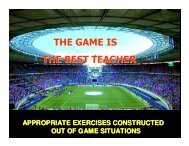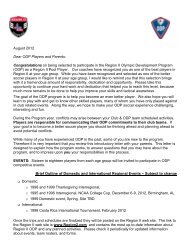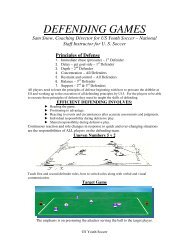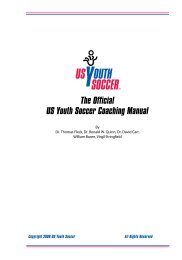Model Soccer Clubs - US Youth Soccer
Model Soccer Clubs - US Youth Soccer
Model Soccer Clubs - US Youth Soccer
You also want an ePaper? Increase the reach of your titles
YUMPU automatically turns print PDFs into web optimized ePapers that Google loves.
<strong>Model</strong> <strong>Soccer</strong> <strong>Clubs</strong>Brett ThompsonBrett ThompsonRegion 2 Girls ODP<strong>US</strong> <strong>Youth</strong> <strong>Soccer</strong> National Staff CoachC<strong>US</strong>A Executive Director
The <strong>Model</strong> <strong>Soccer</strong> Club• The <strong>Model</strong> outlined in this presentation is aimedat enhancing, expanding the growth of soccer inthe United States• This outline shows possible structures of a clubgoing forward in this rapidly ever changingchanging youth soccer environment
The <strong>Model</strong> <strong>Soccer</strong> Club• Hopefully this model will provide an incentive forplayers to stay in the game longer as players andas coaches, aid in the development of the Club,the coach and the player by providing aprofessional learning environment for all threeparties• Success this is a long term process will not occurovernight
The <strong>Model</strong> <strong>Soccer</strong> Club• Decisions made should be based on:– Based first and foremost on the player– Based second upon the team– Based third on the Club– Based fourth on logistics and the family
The <strong>Model</strong> <strong>Soccer</strong> ClubGroup Activity• What are qualities and components ofan ideal soccer club• What are some of the biggestobstacles in achieving goals with youthsoccer today
The <strong>Model</strong> <strong>Soccer</strong> Club• Open <strong>Soccer</strong> Club: Club providing parentadministrators and parent coaching with volunteerpositions only.• Development Club: Volunteer Board andadministrators, with certified coaches who may bevolunteer or paid.• Professional Club: Providing coaching andadministrative support via paid professionals tooffer maximum opportunities to play at the highestlevel.
The <strong>Model</strong> <strong>Soccer</strong> ClubCoaching & Player Development• It is important to realize that many playerdevelopment programs will never functioneffectively if we do not improve our coachingdevelopment programs.• The two programs (Coaching and PlayerDevelopment) cannot be separated and we mustaccept that the quality of player will never improveif the standard of coaching is not improved.• Player retention is tied to the quality of coaching
The <strong>Model</strong> <strong>Soccer</strong> Club• Senior Team’s PDL, MLS, WPS• <strong>Youth</strong> Team’s• Academies• Recreational <strong>Soccer</strong>• TOP<strong>Soccer</strong>
The <strong>Model</strong> <strong>Soccer</strong> Club• Senior Team’s PDL, MLS, WPS (Professional)– The aim and goal here is to win, creatingenthusiasm, an IDENTITY, a club spirit andpotential cash flow. This gives the organizationthe opportunity to create a positive atmospherefor the whole club. It is essential that the playersact as good role models for younger players.
The <strong>Model</strong> <strong>Soccer</strong> Club• <strong>Youth</strong> Team’s– The aim is to build a range of youth age groupsthus creating a Competitive developmentstructure for both players and coaches– In this area having multiple teams that allowmovement between teams is a must fordevelopment
The <strong>Model</strong> <strong>Soccer</strong> Club• <strong>Youth</strong> Team’s– The focus here is to ensure that all players aredeveloped with regards to their age and utilizingage appropriate teaching techniques
The <strong>Model</strong> <strong>Soccer</strong> Club• Academies (8 – 10)– What is your belief system on the Academies• Should players be assigned to teams at an early age• If not, what age should they be• What are the advantages of the Academies– Player movement– Players not pigeon holed into teams or positions• What are the disadvantages of the Academies– Administratively more difficult– Parents do not get the “No team concept”
The <strong>Model</strong> <strong>Soccer</strong> Club• Recreational program– Building a recreational base (Base of thepyramid) for the Club and give players anopportunity to play soccer in a “fun”, safe,developmentally appropriate environment. Thisprogram will be the life line in the appropriateage groups that may supply the competitiveyouth team program.
The <strong>Model</strong> <strong>Soccer</strong> Club• Recreational program; Items needed toimprove in this area– Designate a Grass Roots Development StaffCoach as resource– Distance learning support via the internet– On-line technical support package for club HeadCoaches (Manuals, Training Videos, Fun games ideas)
The <strong>Model</strong> <strong>Soccer</strong> Club• Recreational program; Items needed toimprove in this area– NO ALL-STAR teams for recreational teams or precompetitive teams. Recreational teams can playin any recreational tournaments offered in thearea, we need to de-emphasize the all-starconcept in this area
The <strong>Model</strong> <strong>Soccer</strong> Club• TOP<strong>Soccer</strong> (Program for special needsplayers)– (The Outreach Program for <strong>Soccer</strong>) is acommunity based program that is designed tomeet the needs of children and young adultsthat have physical and/or intellectual disabilities– The program is geared towards playerdevelopment rather than to competition.
The <strong>Model</strong> <strong>Soccer</strong> ClubGroup Activity• Who does a soccer club serve• What services should a soccer clubprovide
Who do we serve?• Primary Customers– Players, Players, Players• Supporting Customers– Parents– Coaches– Volunteers
Club Philosophies• Player Development• Player Movement• Centers of Excellence• Tournaments• League Play
Club Philosophies• Player Development– Are you willing to following establishedguidelines (<strong>US</strong>SF, <strong>US</strong> <strong>Youth</strong> <strong>Soccer</strong>)– Are you willing to lose players (Registrations,$$$$$$) and stick to your core value beliefs
Club Philosophies• Player Development– What are the components your club willfocus on in Player development• Team Training, Age Group sessions• Centers of Excellence• Speed and agility• Functional Training
Club Philosophies• Player Movement– What is your belief system on playermovement• Do you move players from the A team to theB (Vice versa) team or are they there for thewhole time• Do you SHARE players throughout the year(Tournaments, Friendlies)
Club Philosophies• Player Movement– What is your belief system on playermovement• Do you have players play up an age groupwhen appropriate• Do you allow Girls to play with Boys
Club Philosophies• Center of Excellence– A club player development program that allowsplayers aged 12-18 additional, year roundcoaching from the Club DOC and the staffcoaches. This is a long term initiative designedto help raise the playing standards within theclub by establishing good technical/tacticalhabits for the more committed player.
Club Philosophies• Tournaments– At what age do you allow your teams totravel out of state– How many tournaments per year will youallow your teams to go to– Do you select a tournament that is aPARENTS Tournament
Club Philosophies• League Play– How do you decide which leagues yourteams will play in– How many leagues will your teams play in– How many games per year are your kidsgoing to play?? (40 games a year??)
Club Philosophies• ODP– After all this where does ODP fit in withnumber of sessions a player is involved inas well as the number of games theyplay?– Are you willing to adjust your schedule tonot have players have over use issues?
Staffing• Organizational StructureStructure should be designed to enhanceexecution of the clubs strategy
Staffing• Volunteer Coaches• Professional Coaches and Trainers• Directors of Coaching• Executive Director/Director of <strong>Soccer</strong>• Executive Director/Director of <strong>Soccer</strong>Operations
Staffing• Volunteer Coaches (Recreational)– What is their role• Provide a fun practice and game environment• Understands that focus is on development• Does not focus on winning• Provide a safe environment for kids to play• Assist in the transition to Select Programming
Staffing• Age Group Coaches (Professional)• Train teams in accordance with clubphilosophy and curriculum• Attend Games• Provide player evaluations
Staffing• Age Group Coaches (Professional)• Have parent and player meetings• Responsible for working with a specific groupof coaches and players• Develop a player based self training program
Staffing• Age Group Coaches (Professional)• Responsible for mentoring that group ofcoaches under the direction of the Club DOC• Essentially fulfills the task of “Assistant ClubCoach”, encouraged to pursue coachingcertification to the highest level possible
Staffing• Age Group Coaches (Professional)– Length of term – 2 years– Compensation – Based on license level– National <strong>Youth</strong> License– National C license– Age Group Director reports only to the TechnicalDirector
Staffing• Professional DOC’s• Full Responsibility for the Club TechnicalProgram• Involved in the selection of ALL coaches• Should be <strong>US</strong>SF or NSCAA Educated to thehighest level available• Provide evaluations on staff
Staffing• Professional DOC’s• Develop coaching, player and parentmaterials• Monitor coaching licensing within all areas ofthe club• Direct interface with the Board• Develop parent educational materials• Reports directly to the Executive Director
Staffing• Professional DOC’s• Conduct Team tryouts• Face of the Organization• Provides the overall BIG PICTURE– The DOC today is not the same as he / she wasten to fifteen years ago. They M<strong>US</strong>T be proficientin communication by utilizing all available tools.Being a professional coach today is not justaccepting a check
Staffing• Professional DOC’s– Length of term - takes up 3 years to see increasesprogram results– Compensation, Based on license level– Club president and or coaching committeechairperson evaluate the Technical Director– Attends BOD meetings
Staffing Qualifications• Technical Director– A or B (must pass the course within one year),National <strong>Youth</strong> License• Age Group Coach– C, B, or A (must take or audit within one year),National <strong>Youth</strong> License
Staffing Qualifications• Competitive Head Coach– State or National D• Competitive Assistant Coach– E License• U6, U8, U10 and U12 Recreational Coach– U6/U8 or U10/U12 <strong>Youth</strong> Module Certificate
Staffing Administrative• Team Managers• Office Staff• Volunteers/Board Members• Executive Director/Director of <strong>Soccer</strong>• Executive Director/Director of <strong>Soccer</strong>Operations
Staffing Administrative• Team Managers– Provides administrative support to the TeamCoach, direct link to the parents– Responsible team registration for leagues,tournaments, team communications– VITAL in the success of teams and the Club, theyare the sounding board of the parents
Staffing Administrative• Office Staff– Provides overall administrative support to theOrganization and Club DOC– VITAL link to the Coaching Staff as they becomea sounding board and can head off problemsbefore they get out of hand
Staffing Administrative• Volunteers/Board Members– The backbone and support of the organization– Provide the policies by which the organizationoperates– Solicit assistance from within the parent groupto assist with club functions and duties• Tournaments, TOP<strong>Soccer</strong>, Field days
Staffing Administrative• Executive Director/Director of <strong>Soccer</strong>Operations– Responsible for marketing, sponsorships andoverall administration of the Club– Liaise with Club DOC on technical programadministration– Ensures Club Policies are being implemented /fulfilled
Staffing Administrative• Executive Director/Director of <strong>Soccer</strong>Operations– Oversees the day to day running of the club,develops and implements marketing strategies– Ensures the <strong>Soccer</strong> and Business side areworking cohesively– Reports directly to the Executive Board orPresident
Staffing Club WorkingCircle of how it all worksDirectors ofCoachingThe ClubPLAYERClubManagement
Staffing Club StructureSelectProgrammingRecreationalProgrammingProfessionalStaffExecutiveBoardExecutiveDirectorDOC’sTournamentVolunteerCoaches<strong>US</strong> <strong>Youth</strong> <strong>Soccer</strong>
Business• A soccer club is a business and must berun like one– Whether the organization hasprofessionals running it or not, it is stillneeds to run like a business– Many organizations have over a milliondollars running through their checkbook..
Business• SWOT Analysis– Strengths• i.e./ DOC’s, Facilities, Training Programs– Weaknesses• Lack of facilities, funding, qualified staffing
Business• SWOT– Opportunities• Club synergy, sponsorships, connect toProfessional <strong>Clubs</strong>, Access to Media– Threats• Competing organizations, In fightingbetween club parts and adults, Differingvision between decision makers
Business• Benchmarking– Local, regional, national clubs• Indicates how you compare with other clubswithin the areas identified• How do you want to be perceived– What impacts that perception• Have you identified where you want to be inthe food chain of youth soccer clubs
Business• Mission Statement– What is the purpose for your club?• The mission defines the reason for yourexistence!!!• You must communicate your mission• MORE IMPORTANTLY YOU M<strong>US</strong>T LIVE YOURMISSION STATEMENT
Business• Funding– Tournament Hosting• Tournaments are a dime a dozen, separateyours from the others. QUALITY notQUANTITY will get you what you need• Who is your targeted audience• How will you use these funds to offset costs
Business• Funding– Partnerships• Can you partner with vendors you useregularly to help offset club costs– Fundraising• Using kick back programs from local vendorssuch as grocery stores, auctions, Fun Runs..
Business• Formulate a Business Plan– Measures more than financial success,also player and coach development• How will you use the recourses to accomplishyour goals• How will your development of players affectyour financial goals
Business• Formulate a Business Plan– Short Term and Long Term planning• Identifying short term needs and costs– Player Education– Coaching education– Parent Education– Professional staff– Equipment needs (soccer)– Equipment needs (PC, Printers, Projectors etc)
Business• Formulate a Business Plan– Short Term and Long Term planning• Identifying long term needs and costs– Staffing– Facilities– Marketing– Sponsorships– Fundraising– Financial Investments– 501C 3???
Business• Formulate a Business Plan– Short Term and Long Term planning• Should Sponsorship dollars (Soft Dollars) bepart of the short and long term planningwithin BUDGETS?
Business• Budget Preparation– Annually and beyond if possible– Involve a CPA, review by board– Major elements:• Player fees, camps, concessions, spirit wear,coaching fees, facilities, salaries, advertising,tournaments, sponsorships, administrative
Facilities• Impacts programming– Allows you to control when your teamstrain in a quality environment– Provides a physical home/identity thatfeeling of belonging– May increase costs to membership
Facilities• Impacts programming– What would be ideal?• Several grass fields• A Turf type area that is for training• Indoor field for off season / bad weathertraining• Onsite water (Retention pond, Well), will helpkeep costs lower
Idea’s• Develop a “sister club” system to exchangeideas, problems/solutions and personnel• Have a “sister club” in each of the four U. S.<strong>Soccer</strong> regions• Have a “sister club” in each of the FIFAconfederations – CONCACAF, UEFA,CONMEBOL, CAF, AFC & OFC.
The First Step• Dr. Tom Fleck – “We must work to create anenvironment to develop the American player’sgrowth and development! In the past we havetried to train the Dutch way, the Brazilian way, etc.We can and will together create the finest playersin the world if we understand the growth,development and specific characteristics of ouryouth. Distributing the body of information fromthe “Y” License is the first step.”
References• Canadian <strong>Soccer</strong> Association• Indiana <strong>Youth</strong> <strong>Soccer</strong> Workshop 2008• Richard Butler, South Charlotte <strong>Soccer</strong> Association• Dave Simeone, <strong>US</strong> <strong>Soccer</strong>• Jay Howell, CASL Raleigh North Carolina• <strong>US</strong> <strong>Youth</strong> <strong>Soccer</strong>, Sam Snow<strong>Model</strong> <strong>Soccer</strong> ClubBrett Thompsonbthompson@cusasoccer.orgwww.cusasoccer.com


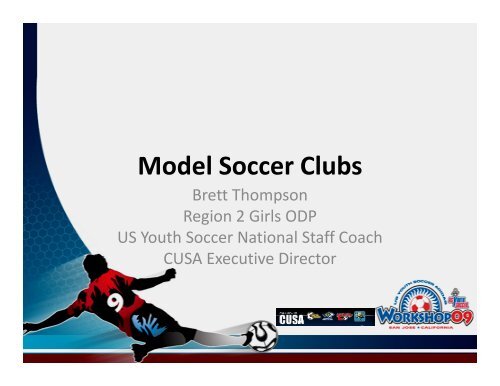
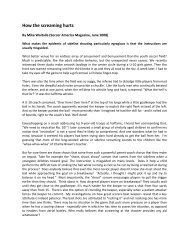


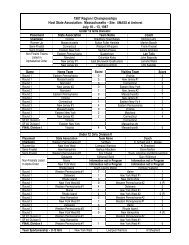

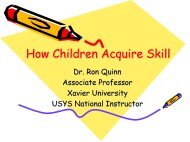
![Informational Letter attached to letter 8/28/2013 [PDF] - US Youth ...](https://img.yumpu.com/47952957/1/190x245/informational-letter-attached-to-letter-8-28-2013-pdf-us-youth-.jpg?quality=85)
